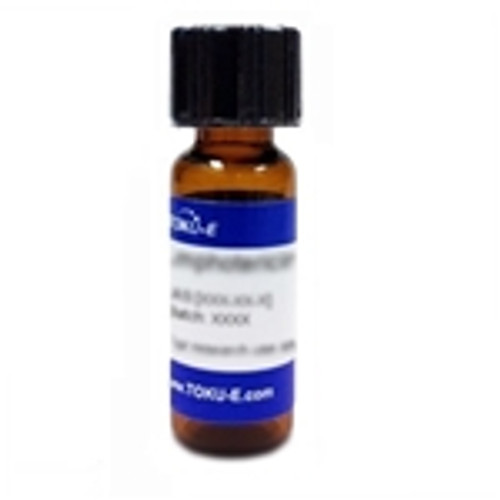Kazusamycin A is a minor member of the Leptomycin complex isolated from some Streptomyces species. It is a hydroxylated analog of Leptomycin B, a nuclear export inhibitor. It is similar to Leptomycins A and B in physico-chemical and biological characteristics. It has anti-cancer properties. It can inhibit nuclear export and Rev translocation, a gene product in HIV-1 genome, at nanomolar concentrations.
Kazusamycin A is soluble in ethanol, methanol, ethyl acetate, acetone, chloroform and benzene, practically insoluble in water, and unstable in DMSO.
We also offer:
| Mechanism of Action |
Members of the Leptomycin complex can induce abnormal condensation of nuclei and arrest cell cycle of yeast and mammalian cells in both G1 and G2 phases, but the exact mechanism of action of Kazusmycin A is still unknown. |
| Microbiology Applications | Kazusamycin A and B, along with Leptomycins A and B were isolated from Streptomyces sp. strain A87-18203. These compounds were identified via a screening assay for low MW inhibitors of Rev nuclear transport. They were all found to inhibit the translocation of the regulatory protein Rev at nanomolar concentrations. Rev is need for viral replication of HIV-1 (Wolff et al, 1997).
Kazusamycin A is the first low low MW inhibitor of nuclear export to be identified. It can be used as a tool to dissect nuclear export pathways. |
| Eukaryotic Cell Culture Applications | Kazusamycin A has strong cytotoxic activity against HeLa cells in vitro, and 3.3 ng/ml conc. prevented cell growth (Umezawa et al, 1984). |
| Cancer Applications | Kazusamycin A has in vitro cytotoxic activity against various human and mouse tumor cell lines. It shows in vivo activity against experimental murine tumors. It has potent in vitro and in vivo activity against P388 and L1210 cancer cell lines.
In a study of urological cancer, Kazusamycin A was evaluated in vitro with transitional cancer cells (KU-1, T-24) and was found to induce G2 cell cycle arrest and delay the M phase of the cell cycle (Sawamura et al, 1992). |
| References |
Komiyama K et al (1985) Antitumor activity of a new antibiotic, Kazusamycin. J. Antibiot. 38:224 Roberts BJ et al (1986) In vivo and in vitro anticancer activity of the structurally novel and highly potent antibiotic CI-940 and its hydroxy analog (PD 114,721). Cancer. Chemother. Pharmacol. 16:95 Sawamura M (1992) Growth inhibitory effect of a new anticancer antibiotics, Kazusamycin A, on human transitional cancer cell lines in vitro. Nihon Hinyokika Gakkai Zasshi. 83(5):627-635 PMID 1495200 Umezawa I et al (1984) A new antitumor antibiotic, Kazusamycin. J. Antibiot. (Tokyo) 37(7):706-711 PMID 6432763 Wolff B et al. (1997) Leptomycin B is an inhibitor of nuclear export: Inhibition of nucleo-cytoplasmic translocation of the human immunodeficiency virus type 1 (HIV-1) Rev protein and Rev-dependent mRNA. Chem. Biol. 4:139 PMID 9190288 |




